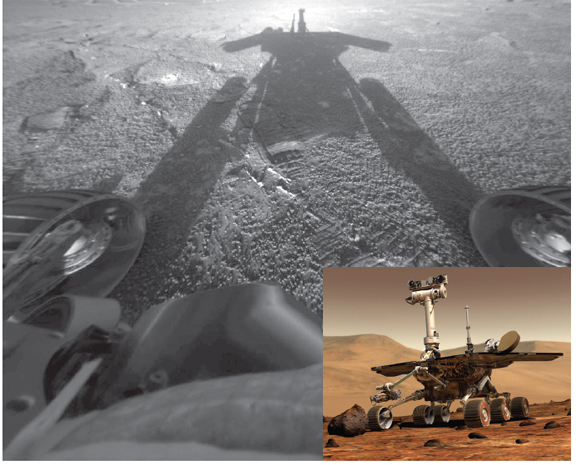Bidding goodbye to the little rover that did much more than expected.

This self-portrait of NASA’s Mars Exploration Rover Opportunity comes courtesy of the Sun and the rover’s front hazard-avoidance camera. The dramatic snapshot of Opportunity’s shadow was taken as the rover continued to move farther into “Endurance Crater.” The image was taken on sol 180 (July 26, 2004), a date that marks achievement of fully double the rover’s primary 90-sol mission.
By Charly SHELTON
In June 2018, a record-setting dust storm blanketed all of Mars, obscuring almost all light coming from the summer sun. In Perseverance Valley, a small rover took in its last drink of sunlight power through its solar arrays and then hunkered down to wait out the storm. With a faulty heater that expends energy and too much interference in the storm to send a shut-off command, the batteries were drained before the storm let up and the rover went to sleep for the final time. After 14 years, the Martian geology rover Opportunity was officially put to rest yesterday, and the team who had worked so hard to keep the rover rolling got to say goodbye.
“I’ve been on this project 18 years, from the development cycle looking at the landing sites, all the way through operations. It’s been half of my career. You know … it’s been great,” said Matt Golombeck, Mars Exploration Rover (MER) project scientist at Jet Propulsion Laboratory, in a press conference held Wednesday.
From June 10, 2018 through Tuesday, Feb. 12, more than 1,000 recovery commands were sent to the rover, hoping that enough power could trickle through the panels to wake it up. On Tuesday the team sent its last message, hoping that the winds of the dust-clearing season may have uncovered the rover’s panels. With a 13-and-a-half-minute light-time message transfer each way, the team waited to see if the message was received. After 27 minutes, there was no response and the team officially ended the mission.
“A robotic geologist on Mars and an integrated science and engineering operations team here on Earth all set out together on a mission of discovery,” said Mike Watkins, director of JPL. “They didn’t know what they would find, they didn’t know which direction they would go – sometimes from one day to the next – and they made it work, longer than any of us thought possible by both brilliant scientific deduction of where to go and brilliant engineering to keep the rover alive.”
Opportunity landed in the Meridiani Planum region of Mars on Jan. 24, 2004, seven months after its launch from Cape Canaveral Air Force Station in Florida. The original mission parameters of MER were 90 Martian days with a possible area coverage of one kilometer. After more than 14 years and 45 kilometers, Opportunity has far surpassed its life expectancy and been exploring long past what many thought possible, and even surpassed its twin. Opportunity’s twin companion rover, Spirit, also exceeded the 90-day, one-kilometer mark when its mission ended in May, 2011 after eight kilometers travelled.
MER Project Manager John Callas reminisced about the early days of the rovers’ infancy, when he had to pick up overnight shifts to keep an eye on the rovers while they were being built, and what it is like to say goodbye.
“[These overnight shifts were] very meaningful, very touching because it was just me with the two rovers when the rovers were in the clean room, like a neonatal care facility. And they had all the life-support equipment; you would watch their vital signs and you would see their heart rates, and you would see the voltages and temperatures and currents. They would be living and you would see them wake and sleep,” Callas said. “During those times when it was just me, you develop a special bond and they become your children. I think that’s true for so many people here today, that they have that strong connection. So even though it’s a machine and we’re saying goodbye, it’s still very hard and very poignant.”
